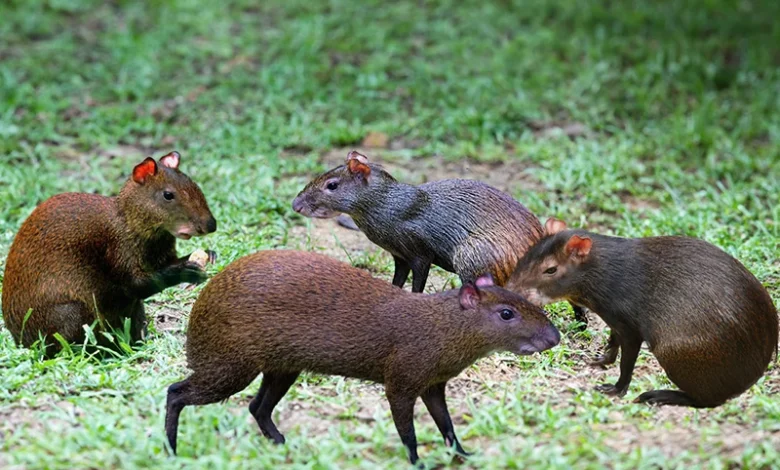Agouti – Red-Rumped

The Agouti in Dominica, specifically the Red-rumped Agouti (Dasyprocta leporina), plays a vital role in the island’s ecosystem and culinary traditions, particularly during festive events like Independence celebrations and Creole Day. This small rodent, native to the Caribbean and Central America, is known for its brownish-red fur and ability to adapt to forested and agricultural areas.
Agoutis Habitat, Breeding, and Life Span
Agoutis typically seek shelter in burrows or beneath natural cover, such as dense vegetation or fallen logs, and are primarily diurnal, meaning they are most active during daylight hours. However, if they feel threatened, their activity may shift to dusk. In Dominica, agoutis thrive in the island’s rainforests and secondary forests, particularly in areas like Morne Diablotin National Park, Central Forest Reserve and Morne Trois Pitons National Park, which offers a rich biodiversity and an abundant food supply. These rodents favour habitats near water bodies or with dense foliage to help them hide from predators. They play a crucial ecological role in seed dispersal, maintaining the island’s forest ecosystems.
The agouti is a monogamous species that forms long-term pair bonds. They breed year-round, with females giving birth twice a year, typically to 1-3 young after a gestation period of around 104 to 120 days. The young agoutis are highly mobile just an hour after birth, an adaptation that helps them escape predators. The average lifespan of the red-rumped agouti in the wild is 15 to 20 years, but they can live longer in captivity.
Agouti Culinary and Cultural Importance
Agouti meat is considered a delicacy in Dominica, especially during the island’s Creole Heritage Month. The animal is typically hunted during the hunting season, which coincides with important cultural events, such as Independence Day and Jounen Kwéyòl celebrations. Locals prepare the meat in various traditional ways, with popular dishes including agouti water, a spiced broth, and stewed agouti, often served with rice, ground provisions, and vegetables. These dishes are widely enjoyed during Creole Day and at festive gatherings, where they are served alongside other local favourites such as Manicou – Opossum.
The indigenous people of Dominica, the Kalinago, have long hunted agouti for sustenance, making it a part of their cultural heritage. The practice of hunting agouti for food has been passed down through generations, ensuring that this tradition remains alive today. It is particularly notable during the celebration of Kalinago Week, where the community celebrates its rich cultural legacy.
Hunting and Conservation Efforts
In recent years, hunting regulations have been implemented to ensure the sustainable population of agouti, as the species faces threats from overhunting and habitat destruction. The government has designated specific hunting seasons to prevent overexploitation, allowing the species to thrive while supporting cultural practices. The Forestry, Wildlife, and Parks Division are key in monitoring hunting activities and promoting wildlife conservation across the island.
Conservation efforts aim to balance traditional practices like hunting with the need to protect wildlife, ensuring the agouti remains a part of the island’s natural and cultural heritage. These efforts align with broader initiatives to preserve the country’s biodiversity and promote sustainable eco-tourism, which includes protecting the natural habitats where agoutis and other wildlife live.




